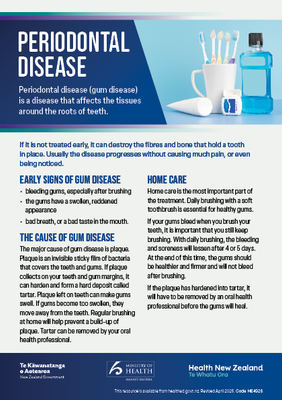Periodontal Disease - HE4928

Causes and signs of periodontal (gum) disease - plaque and tartar - and how to care for your gums. Please note that this is now an online-only resource.
The full resource:
Periodontal disease (gum disease) is a disease that affects the tissues around the roots of the teeth.
If it is not treated early, it can destroy the fibres and bone that hold a tooth in place.
Usually the disease progresses without causing much pain, or even being noticed.
Early signs of gum disease
- bleeding gums, especially after brushing
- the gums have a swollen, reddened appearance
- bad breath, or a bad taste in the mouth.
The cause of gum disease
The major cause of gum disease is plaque. Plaque is an invisible sticky film of bacteria that covers the teeth and gums. If plaque collects on your teeth and gum margins, it can harden and form a hard deposit called tartar. Plaque left on teeth can make gums swell. If gums become too swollen, they move away from the teeth. Regular brushing at home will help prevent a build-up of plaque. Tartar can be removed by your oral health professional.
Home care
Home care is the most important part of the treatment. Daily brushing with a soft toothbrush is essential for healthy gums.
If your gums bleed when you brush your teeth, it is important that you still keep brushing. With daily brushing, the bleeding and soreness will lessen after 4 or 5 days. At the end of this time, the gums should be healthier and firmer and will not bleed after brushing.
If the plaque has hardened into tartar, it will have to be removed by an oral health professional before the gums will heal.